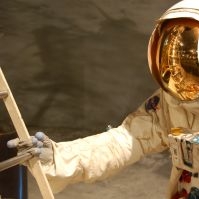NASA SPHERES Sending Google Technology to Space

NASA and space exploration just became more like something out of the realm of science fiction—and Google played a role in it.
About a year ago it was announced that NASA was turning to technology known as SPHERES, an acronym for synchronized position, hold, engage, and reorient experimental satellites. Since the tech is spherical in nature, it’s easy to imagine the moniker would have caught on regardless of the acronym.
The spheres, which are roughly the size of basketballs, look very similar to the free-flying robots in the original Star Wars films (think of Luke Skywalker’s Jedi training).
The Star Wars similarity actually has some relevance to the story. SPHERES originated from aeronautical engineers at MIT, where professor David Miller challenged his class to build the very same floating droids from A New Hope, the movie he showed his class on the first day of lessons.
Although the project has come a long way from its classroom origins, the inspiration and direction of the project has held true to the Star Wars universe. Even Terry Fong, the director of Intelligent Robotics Group at NASA, claims the project’s muse “comes from Star Wars, as all good things do.”
Beginning in October, SPHERES will begin to incorporate Google’s Project Tango technology to help NASA increase overall efficiency. Project Tango is a smartphone platform designed for 3D mapping and includes a series of sensors and cameras that NASA needs for its robots to tackle tasks aboard the International Space Station.
Google’s Tango will allow for the devices to automatically calculate their distance from anything while on board the space station. This makes the robot 100 percent autonomously efficient to more effectively navigate its tasks.
In 2003 SPHERES were around in a very basic capacity. In just ten years, SPHERES have evolved to be able to autogenerate 3D maps without requiring physical beacons; test air quality; and take inventory of tools, food, and instruments. If that isn’t enough, SPHERES can measure sound, light, and radiation levels—and they look pretty futuristically awesome.

